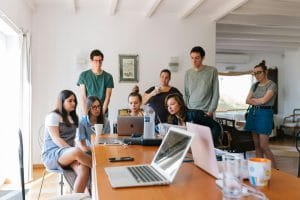Introduction
The Human Element cluster is shaped by physical health, mental resilience, employment opportunities, social interactions, cognitive skills, and inclusivity for vulnerable groups. This cluster analyses the diverse factors influencing individual experiences and group dynamics. By leveraging data-driven insights, we can identify patterns that help target interventions to improve quality of life.
From the THRIVE Framework, the Foundational Focus Factor (FFF) Systems Thinking helps us understand how individual behaviours and societal structures interact in complex and dynamic ways. This highlights the importance of addressing interconnected factors rather than isolated issues. Meanwhile, Materiality ensures our focus remains on the factors that most significantly influence human well-being in varied contexts. It recognises the diverse challenges faced by different populations.
This analysis goes beyond macro-level governance to focus on the human element, recognising how individual behaviours and the opportunities and challenges people face shape society. From healthcare access to employment stability, and mental health resilience to the treatment of marginalised groups, this cluster explores what it means to thrive in an equitable world as an individual and as part of a society.
Physical Health: A Foundation for Thrivability
Physical health is a cornerstone of individual and societal thrivability. It impacts overall well-being, longevity, life satisfaction, and economic productivity. Physical health encompasses body composition and physical fitness, nutrition and diet, sleep and rest, pain and injury management, and sexual and reproductive health. Physical health also involves proactively managing risks and regularly engaging with healthcare providers for preventative care.
From the THRIVE Framework perspective, Materiality reminds us to focus on what matters most in context, such as equitable access to care and nutrition. The Multi-Capital approach recognises that diverse forms of capital; human, social, natural, and financial, support health. Meanwhile, Context-Based Metrics emphasise measuring health outcomes in relation to specific local and cultural conditions, ensuring interventions are relevant and effective.
“The man who uses intelligence with respect to his diet, his sleeping habits and who exercises properly, is beyond any question of doubt taking the very best preventive medicines provided so freely and abundantly by nature.”
– Stephen A Margolis
Weight and physical fitness
While body weight is often discussed in health contexts, it’s important to avoid oversimplification. Many health issues are misattributed to weight alone, which can lead to misdiagnosis and delayed care (Phelan et al., 2015). Instead, a weight-inclusive approach that focuses on behaviours and overall well-being is recommended (Tylka et al., 2014).
Body Mass Index (BMI), though still widely used, is increasingly criticised as outdated. It does not account for muscle mass, body composition, or ethnic variation, making it an unreliable individual health measure (Nuttall, 2015; Tomiyama et al., 2016).
Regardless of body size, regular physical activity supports cardiovascular health, strengthens muscles and bones, reduces disease risk, and improves mental well-being (National Institutes of Health, 2024).
Nutrition and Diet
A balanced diet, or consuming a balanced intake of essential nutrients, is fundamental to overall health. Consuming a variety of fruits, vegetables, whole grains, lean proteins, and healthy fats provides essential macronutrients and micronutrients that support energy production, immune function, and cellular repair. According to a statement by the World Health Organization, proper nutrition reduces the risk of all forms of malnutrition, including undernutrition, micronutrient deficiencies, and overnutrition, as well as several major Non-Communicable Diseases (NCDs). These include heart disease, type 2 diabetes, colorectal and other cancers, and stroke (World Health Organization, 2020). It also plays a vital role in emotional regulation and cognitive development, particularly during early childhood and adolescence (Black et al., 2013).
Nutrition and Food Access
Food insecurity, often tied to low income or geographic isolation, contributes to poor dietary habits and increased rates of obesity and diabetes. Public health strategies must prioritise food education, subsidies for fresh produce, and infrastructure that connects communities to nutritional food sources (Samsom & Hannibal, 2021).
Sleep and rest
Adequate sleep and rest encompass the processes by which the body recovers and rejuvenates itself. It is critical for physical recovery, cognitive function, and emotional resilience. Sleep deprivation increases the risk of obesity, cardiovascular disease, and diabetes, and impairs mental performance (Muscogiuri et al., 2020; Antza et al., 2021; Khan & Hamda, 2023). Encouraging adequate sleep can improve workplace productivity and overall health outcomes.
Pain and injury management
Effective pain management strategies, such as rehabilitation therapies, address the root cause of dysfunction rather than merely alleviating symptoms. The National Health Strategic Plan for Pain Management advocates a comprehensive care approach, emphasising self-management to alleviate the burden of chronic pain on individuals and the community, while enhancing the quality of life for those affected by this condition. Chronic pain interventions can enhance productivity by reducing absenteeism and improving return to work rates (Australian Department of Health, 2021).
Sexual and reproductive health
Sexual and reproductive health are crucial for lifelong health, encompassing physical, mental, social, and workforce health. In everyday life, this also implies safe sexual practices, and the ability to decide if, when, how, and the frequency with which to have children, and that this occurs safely. Access to sexual and reproductive health services is critical for promoting gender equity, improving educational and outcomes, and enhancing overall community well-being (World Health Organisation, 2022).
Preventative Care
Preventative care involves proactive measures such as screenings, vaccinations, and lifestyle counseling to prevent or detect the incidence of diseases at the earliest stage. Engaging in preventative healthcare practices helps detect health issues early, promotes overall well-being, and reduces long-term healthcare costs by preventing serious health problems. The National Preventive Health Strategy seeks to enhance the health and well-being of all Australians across various life stages by adopting a Systems Thinking based approach to prevention. This strategy targets broader determinants of health, aims to reduce health inequities, and strives to diminish the overall burden of disease (National Preventive Health Strategy, 2021–2030).
Access and equity issues
Disparities in access to health services based on income, geography, or social demographics hinder thrivability. Addressing these inequalities through targeted funding and inclusive health models ensure more equitable health outcomes across populations. According to the guidelines by the National Health Medical Research Council (NHMRC), every individual should possess an equitable opportunity to realise their complete health potential, and no one should face disadvantages in realising this potential if it can be prevented.
Physical health and thrivability
Physical health underpins thrivability be enabling individuals to live fulfilling lives while contributing to societal progress. Holistic approaches integrating fitness, nutrition, sleep, pain management, reproductive care, preventative measures, and equitable access are essential for fostering sustainable well-being at both individual and community levels.
The Prevalence of Physical Health Challenges
Globally, chronic conditions such as arthritis, diabetes, and back problems significantly impact the quality of life. In Australia, 81% of people had at least one long-term health condition in 2022, with back problems and arthritis being the most prevalent (ABS, 2023). These conditions not only diminish individual well-being but also strain healthcare systems and reduce workforce participation. Addressing them through prevention and better management is essential for fostering thrivability, a sustainable state where individuals and communities flourish.
Work-Related Physical Health Stressors
Modern work environments contribute to physical ailments, particularly musculoskeletal disorders caused by prolonged sitting and repetitive tasks. Chronic musculoskeletal conditions affected around 7.3 million people in Australia in 2022, that’s about 29% of Australians (Australian Institute of Health and Welfare, 2024). Employers can reduce these risks by adopting ergonomic designs, encouraging movement breaks, and implementing workplace wellness programmes. These actions enhance physical health and boost productivity, engagement, and job satisfaction (World Health Organization, 2020).
Proactive Strategies for Better Living
Preventive health behaviours, such as regular exercise, a balanced diet, and limiting sedentary habits, reduce the risk of chronic illnesses like cardiovascular disease and obesity. The Australian Institute of Health and Welfare (AIHW, 2018) recommends at least 150 minutes of moderate activity per week to improve cardiovascular health and prevent diabetes. Lifestyle choices like walking or cycling to work also contribute to environmental sustainability while promoting personal well-being (WHO, 2020).
Healthcare Access and Equity
Access to affordable, quality healthcare is vital for individual and community thrivability. However, disparities in healthcare accessibility persist across income, geography, and social demographics. Vulnerable populations often face the greatest challenges in obtaining preventive care and treatment. Bhatt and Bathija (2018) emphasise that addressing these disparities requires innovative solutions, including targeted funding, resource distribution, and inclusive health models.
Ensuring equitable access not only improves physical outcomes but also reduces financial strain, enabling more people to live healthy, productive lives. Holistic healthcare approaches that integrate physical, mental, and community health are essential for advancing public well-being.
Sleep and Recovery
Quality sleep is often overlooked in health discussions, yet it is critical for physical and mental recovery. Inadequate or disrupted sleep is linked to obesity, cardiovascular disease, and impaired cognitive function. Encouraging good sleep hygiene and reducing work-related stressors can significantly improve individual health outcomes (Muscogiuri et al., 2020; Antza et al., 2021; Khan & Hamda, 2023).
The Role of Thrive Project
THRIVE Project offers a wealth of resources, including educational materials, blog posts, partner networks, and research findings, focused on thrivable health. By utilising this data, individuals, healthcare professionals, and policymakers can foster a shared understanding of the conditions that support sustainable well-being. Through awareness and collaboration, we can create environments where everyone has the opportunity to live a healthy and fulfilling life.
Employment
Employment is a key area affecting a person’s lived experience, their attitudes, mental state, and choices. It is therefore essential to consider, when assessing thrivability, whether linked to financial security, work-life balance, stress, mindfulness, and meaningful work.
From the THRIVE Framework’s Materiality perspective, what truly matters in employment is not just having a job, but ensuring job quality, stability, and fair access. The Multi-Capital factor highlights that employment influences and depends on multiple capitals, including social connections, economic resources, and individual well-being. Furthermore, Systems Thinking helps us understand how employment interacts with mental health, community engagement, and economic systems, emphasising the need for integrated solutions to improve thrivability.
Job Satisfaction and Career Stability
People who feel satisfied in their jobs experience higher motivation, productivity, and overall happiness. Job satisfaction strongly correlates with positive mental health outcomes, while job dissatisfaction increases stress and burnout (Warr & Nielsen, 2018). Employment stability also contributes to well-being, reducing financial anxiety and providing individuals with a sense of purpose. However, precarious work, such as short-term contracts or unstable gig jobs, can lead to stress and uncertainty, negatively impacting psychological health.
The Impact of Work-Life Balance on Individuals
Achieving a healthy work-life balance is essential for long-term well-being. People who overwork, especially in high-pressure environments, often suffer from chronic stress, fatigue, and reduced personal time. Employees who work excessively long hours without sufficient rest are more likely to experience burnout, leading to emotional exhaustion and disengagement (Maslach & Leiter, 2016). Conversely, individuals who establish clear boundaries between work and personal life report greater satisfaction and lower stress levels. Flexible working conditions, including remote work and adaptable schedules, can significantly improve individual well-being and reduce work-induced anxiety.
Job Loss and Psychological Resilience
Losing a job can have severe emotional and psychological effects, often leading to stress, self-doubt, and financial insecurity. Individuals experiencing job loss are at a higher risk of developing depression and anxiety owing to feelings of uncertainty and reduced self-esteem (Paul & Moser, 2009; Blustein et al., 2020). However, resilience plays a critical role in how individuals cope with unemployment. Those with strong problem-solving skills, a supportive network, and a proactive mindset tend to recover more quickly. Upskilling, career coaching, and networking help individuals regain confidence and re-enter the workforce more effectively, turning setbacks into opportunities for personal and professional growth.
Mental Health
Mental health and well-being are core components of an individual’s lived experience. They are central to thrivability and connect to many different areas. Mental health includes working in a positive workplace, having meaning in one’s life, being socially included, connected and supported, as well as having access to mental health resources.
Depression, Anxiety, and Work-Related Stress
Mental health is deeply intertwined with daily experiences, including work, relationships, and financial stability. Depression and anxiety are among the most common mental health conditions, affecting millions of people globally. Over 280 million people live with depression globally (WHO, 2022). Work-related stress, long hours, and high expectations further exacerbate these issues, contributing to emotional exhaustion and physical fatigue. Mindfulness, coping tools, and early support help manage mental health.
The Role of Social Support in Mental Well-Being
Strong social connections play a vital role in maintaining mental health and emotional resilience. Research by Holt-Lunstad et al. (2020) found that individuals with strong support systems experience lower levels of stress and anxiety compared to those who feel socially isolated (Holt-Lunstad et al., 2020). Personal relationships help individuals navigate difficult emotions and provide a sense of belonging. Conversely, social isolation increases the risk of depression and even physical health issues. Actively engaging in social activities and maintaining meaningful connections are key strategies for protecting mental well-being.
Access to Mental Health Resources for Individuals
Despite growing awareness, many individuals struggle to access mental health support owing to financial barriers, stigma, or lack of resources. The World Health Organization (2022) reports that nearly 75% of people with mental disorders in low-income countries do not receive treatment (WHO, 2022). Even in developed nations, mental health services can be costly or difficult to access. Digital mental health solutions, such as teletherapy and AI-driven counselling platforms, provide alternatives for those unable to seek traditional therapy. Regular self-care practices, such as journaling, physical activity, and relaxation techniques, also play a crucial role in maintaining emotional well-being (Mental Health Foundation, 2024).
This focus on mental health and resilience is captured by the THRIVE Framework’s Foundational Focus Factors, Materiality, which emphasises prioritising mental well-being in context; the Entity Model, recognising the interconnectedness of individual and community mental health; and Values-Based Innovation, promoting compassionate, equitable, and accessible mental health support systems.

Source: Pexels
Social Interaction and Community Engagement
Social interaction and community engagement are fundamental aspects of thrivability that influence how we connect, grow, and support one another. Grounded in the THRIVE Framework’s Systems Thinking, these interactions are understood as part of interconnected social ecosystems where resilience, inclusivity, and innovation emerge through dynamic relationships. Additionally, the Multi-Capital Approach recognises that social capital, the value of networks and relationships, is vital for creating conditions in which individuals and ecosystems can thrive.
In this section, we will explore key aspects of social interaction and community engagement. We also explore the impact of digitalisation, barriers to social interaction, and how loneliness affects mental health. Each of these elements contributes to building thriving, resilient communities (Helliwell et al., 2023).
Social connectedness and the size of personal networks
A strong social network provides emotional support, practical help, and a sense of belonging, all vital to mental well-being. Larger and more diverse networks help reduce depression and stress by providing varied channels for emotional expression and shared experiences. Strong networks also enhance resilience when facing life’s challenges (Goldman, 2023). Therefore, building and maintaining meaningful relationships is essential for long-term well-being and preventing loneliness.
Community engagement, participation, and societal trust
When individuals participate in community activities such as volunteering or advocacy, it enhances their self-confidence and strengthens social bonds. Community engagement helps reduce social isolation and builds trust in institutions, as people feel more personally connected to systems that affect their lives. Engaged communities cultivate a sense of belonging and improved well-being. Moreover, high community involvement correlates with greater trust in institutions, as individuals feel personally connected to the structures around them (Attree, 2011).
Impact of digitalisation on social relationships
During times of crisis, like the COVID-19 pandemic, tools such as video calls and messaging apps played a critical role in preserving social ties. However, over-reliance on digital tools can decrease the frequency and quality of in-person interactions. This may contribute to a sense of superficial connection and increased loneliness in the absence of shared physical experiences (Mazzella, 2024).
Barriers to social inclusion: language, mobility, and financial constraints
Language differences, mobility limitations, and financial hardship can all create barriers to full social participation. Groups such as migrants, older people, and people with disabilities often face multiple obstacles that reduce access to education, work, and community life (Nyqvist, 2021). Poor infrastructure and limited digital access further restrict inclusion. Addressing these systemic challenges is essential to building equitable and connected communities (Sen, 2000).
Loneliness and its effects on physical and mental health
Loneliness is a public health concern. Notably, weak social ties can contribute to depression, anxiety, cognitive decline, Alzheimer’s, and heightened stress levels (Mann, 2022). Furthermore, it can lead to heart disease, obesity, and weakened immunity. Prolonged social exclusion may lead to premature death (NIH, 2019). Promoting inclusive social environments and policies that support engagement is critical for individual well-being and societal stability.
Cognitive Intelligence
Cognitive intelligence refers to mental capabilities that support learning, problem-solving, and adaptation. It involves reasoning, memory, attention, and language, all essential for personal and professional growth. Recent studies show that cognitive abilities, including learning potential and endurance, alongside traits like emotional intelligence and resilience, are strong predictors of well-being, academic and career success, and even longevity (Mashburn et al., 2023).
However, from the THRIVE Framework’s Materiality perspective, what truly matters is not intelligence for its own sake, or even for competitive advantage, but its contribution to long-term human flourishing: well-being, adaptability, mental resilience, and equitable access to opportunity.
Cognitive Intelligence and Life Outcomes
Cognitive intelligence, encompassing abilities such as reasoning, problem-solving, and adaptability, has been consistently linked to significant life outcomes. Recent research indicates that higher cognitive abilities are strong predictors of academic achievement and career success. For instance, a study found that cognitive ability significantly influences academic performance, with self-discipline playing a mediating role in this relationship. Moreover, cognitive flexibility and problem-solving skills are essential for career adaptability and success in dynamic work environments (Shi & Qu, 2022).
Beyond academic and career domains, cognitive intelligence also impacts health and longevity. Individuals with higher cognitive abilities tend to adopt healthier lifestyles, manage stress more effectively, and exhibit greater resilience, leading to reduced risks of chronic diseases and depression. Furthermore, intelligence has been associated with lower mortality rates, suggesting a link between cognitive function and overall life expectancy (Sanchez-Izquierdo et al., 2023).
Fluid vs. Crystallised Intelligence
Understanding cognitive functioning involves distinguishing between fluid and crystallised intelligence. Fluid intelligence (Gf) refers to the capacity to reason and solve novel problems, independent of acquired knowledge. It is crucial for tasks requiring adaptability and peaks in early adulthood (Schroeders et al., 2021). In contrast, crystallised intelligence (Gc) encompasses accumulated knowledge and skills gained through experience and education, typically increasing over time (Bensley, 2023).
Both types interact dynamically, and fluid reasoning helps acquire knowledge that later contributes to crystallised intelligence (Anglim et al., 2022), exemplifying Systems Thinking in cognitive development..
Measuring Cognitive Intelligence
Psychologists employ various standardised assessments to evaluate cognitive abilities. The Wechsler Adult Intelligence Scale-Fourth Edition (WAIS-IV) measures verbal comprehension, perceptual reasoning, working memory, and processing speed (Abdelhamid et al., 2021). Raven’s Progressive Matrices assess abstract reasoning and fluid intelligence through nonverbal problem-solving tasks (Benade, 2023). Additionally, the Cognitive Abilities Test (CAT4) is utilised in educational settings to evaluate verbal, nonverbal, quantitative, and spatial reasoning (Privitera et al., 2022). These assessments provide insights into individuals’ learning potential, problem-solving capabilities, and adaptability, reflecting the THRIVE Framework’s FFF of Context-Based Metrics.
Technology and Cognitive Development
Digital technologies can support cognitive development through interactive learning and adaptive systems. These tools exemplify Values-Based Innovation when designed to promote equity, accessibility, and long-term well-being rather than efficiency alone. However, heavy reliance on these tools may negatively impact critical thinking and memory retention over time. For example, frequent dependence on AI for information retrieval may lead to reduced long-term memory retention, a phenomenon sometimes referred to as “digital amnesia.” Additionally, algorithm-driven content curation can fragment attention, making it harder to sustain focus and engage in deep, reflective thinking (Deckker, 2025).
Artificial intelligence (AI) and adaptive learning systems offer personalised educational experiences, improving retention and cognitive flexibility more effectively than traditional methods (Halkiopoulos & Gkintoni, 2024). Nevertheless, reliance on digital tools for daily tasks, known as cognitive offloading, may reduce mental engagement (Gerlich, 2025). This underscores the importance of balancing technology use with active cognitive participation to maintain and develop cognitive abilities.
Environmental and Educational Influences
Innate factors do not solely determine cognitive intelligence; environmental and educational influences can significantly shape it, reinforcing Strong Sustainability to support mental and social flourishing across generations. Educational attainment has been shown to enhance fluid and crystallised intelligence, with each additional year of schooling contributing to measurable increases in IQ (Judd et al., 2022).
Early childhood programs, such as the Abecedarian and Perry Preschool Projects, have demonstrated long-term cognitive and life benefits for participants, including improved academic performance and socio-emotional development (Ramey & Ramey, 2023). These findings highlight the role of early educational interventions in fostering cognitive growth. Moreover, the concept of neuroplasticity suggests that engaging in lifelong learning activities, such as reading, studying new languages, and participating in mentally stimulating tasks, can continue to enhance intelligence into adulthood (Staneiu, 2023).
Inclusivity for Vulnerable populations
Ensuring an inclusive society requires recognising and addressing the unique challenges faced by vulnerable populations, including older people, children, and individuals with disabilities. These groups often experience barriers to healthcare, education, employment, and social participation, leading to marginalisation and reduced well-being. Inclusive policies and practices not only benefit vulnerable groups but also contribute to a more equitable and innovative society. Key considerations for inclusivity for this group include healthcare access, education and employment opportunities, infrastructure and accessibility, digital inclusivity, and social integration and discrimination (National Academies of Sciences, Engineering, and Medicine, 2017).
Within the THRIVE Framework, Materiality guides us to focus on the most critical needs and challenges faced by vulnerable populations, ensuring that efforts address what truly matters to these groups. Complementing this, Values-Based Innovation drives the creation of solutions grounded in fairness, dignity, and inclusion, fundamental principles for building equitable and thriving communities.

Source: Pexels
Healthcare Access
Vulnerable populations require specialised healthcare services, including geriatric care, pediatric services, and disability-specific treatments. Access to affordable and quality healthcare remains a critical concern. Ensuring that healthcare infrastructure supports accessibility, from physical access in hospitals to digital health solutions, is essential to fostering an inclusive healthcare system (Byers et al., 2018).
Education and Employment Opportunities
Inclusive education systems that accommodate diverse learning needs, as well as workplace policies that promote equal employment opportunities, are essential for social and economic integration. Schools and workplaces should implement adaptive learning environments, flexible policies, and anti-discrimination measures to create equitable opportunities for all (UNESCO, 2017).
Infrastructure and Accessibility
Public transportation, housing, and workplace environments should be designed with universal accessibility standards to accommodate individuals with mobility challenges or sensory impairments. Investments in smart infrastructure, urban planning, and assistive technologies can significantly enhance the autonomy and mobility of individuals with disabilities (Setiawan, 2025).
Digital Inclusivity
The growing dependence on technology in education, employment, and daily life highlights the need for digital accessibility, ensuring that online resources, applications, and communication tools are designed to be inclusive. Implementing accessibility features, such as screen readers, captioning services, and adaptive user interfaces, can bridge the digital divide for individuals with disabilities and older adults (WHO, 2022).
Social Integration and Discrimination
Stereotypes and biases often hinder the social participation of these groups. Community programmes and legal frameworks should promote inclusion and prevent discrimination. Advocacy campaigns, workplace diversity initiatives, and inclusive community engagement efforts are crucial to dismantling barriers to full participation in society (UNDESA, 2018).
Interconnections Between These Dimensions
Well-being is a multidimensional construct where different aspects of health, economic stability, social interaction, cognition, and inclusivity are deeply interconnected. Addressing well-being in silos leads to incomplete solutions, whereas a holistic approach can create sustainable and effective interventions. (Stiglitz, J. E., Sen, A., & Fitoussi, J. P., 2009).
Physical and Mental Health Benefits of Green Spaces
The THRIVE Framework’s Strong Sustainability emphasises the importance of maintaining environmental health alongside human well-being, recognising that access to natural spaces is vital for thriving communities. Additionally, Context-Based Metrics support tailoring interventions to specific local environments and populations, ensuring equitable access to restorative green spaces and innovative technological alternatives.
Over the past several decades, researchers across fields, from environmental psychology to public health, have built a strong body of evidence demonstrating that green spaces provide measurable benefits for both physical and mental health. Time spent in natural environments is no longer viewed as just a pleasant break from daily life but rather a necessity for human well-being. From lowering stress to boosting immune health, green spaces are fundamental to Thrivability, the concept of enabling people and ecosystems to flourish together.
Physical Health Benefits of Green Spaces
Cardiovascular Health and Physical Activity
Numerous studies show that proximity to green spaces encourages regular physical activity, especially low-impact movement like walking, jogging, or cycling. The World Health Organization (WHO) and public health researchers agree that regular exercise in green environments reduces the risk of heart disease, stroke, and obesity (Shahid et al., 2025).
A 2022 meta-analysis found that living near green spaces is associated with lower blood pressure, improved heart rate variability, and reduced risk of cardiovascular disease (Liu et al., 2022). Green spaces not only facilitate movement but also reduce air pollution, contributing to better respiratory health, particularly in urban areas.
Immune Function
Forest environments, particularly forests with high biodiversity, release phytoncides, natural compounds produced by trees and plants. Multiple studies, especially in Japan and South Korea, demonstrate that inhalation of phytoncides can enhance immune function by increasing natural killer (NK) cell activity, which plays a role in fighting infections and even some cancers (Lew & Fleming, 2024).
A 2021 study found that individuals participating in forest bathing (shinrin-yoku) experienced significant boosts in NK cell activity, lasting for up to a month after their forest visit, suggesting that even short-term exposure to biodiverse forest environments can have long-lasting benefits for immune health (Chae et al., 2021).
Mental Health Benefits of Green Spaces
Stress Reduction and Mood Improvement
One of the most well-documented benefits of green spaces is their ability to reduce stress and improve mood. Research consistently shows that time spent in nature is linked to lower levels of cortisol, the stress hormone. Spending time in natural environments has been shown to reduce cortisol levels, a key indicator of stress. Research suggests that even brief encounters with nature, often referred to as “green time,” can help ease stress and tension by lowering this stress hormone (Yao et al., 2021).
Improved Cognitive Function
Spending time in nature has also been shown to enhance cognitive performance, particularly attention and memory. This aligns with Attention Restoration Theory (ART), a well-supported framework developed by environmental psychologists Rachel and Stephen Kaplan. ART posits that natural environments engage the brain in “soft fascination”, gentle, effortless attention that allows the cognitive system to recover from the fatigue caused by focused work or urban overstimulation (Pham & Sanocki, 2024).
A 2024 study at the Max Planck Institute for Human Development in Berlin showed that participants who took a 90-minute walk in nature experienced reduced activity in the subgenual prefrontal cortex, a brain region associated with rumination and negative thought patterns, indicating that nature exposure can interrupt harmful mental loops (Sudimac, 2024).
Prevention and Relief from Depression and Anxiety
A growing body of research supports the role of green spaces in preventing and alleviating symptoms of depression and anxiety. Natural environments promote relaxation and encourage physical and social activity, all of which play protective roles against mental illness.
A 2021 review in the Journal of Public Mental Health found that living near green spaces is linked to lower rates of depression, particularly in urban areas, where nature can buffer the stressors of city living (Keenan et al., 2021). From a Materiality lens, access to restorative environments should be prioritised as they are essential to human and ecological vitality.
When Access to Nature Isn’t Possible: Exploring VR as a Supplement
While real-world nature exposure is ideal, not everyone can easily access green spaces. Individuals in remote locations, people with mobility restrictions, or those working in isolated environments (such as offshore oil platforms or ships) may struggle to experience the restorative benefits of nature. For these groups, Virtual Reality (VR) is emerging as a promising complementary tool, an example of Values-Based Innovation that delivers therapeutic benefits through immersive, restorative environments (Anderson et al., 2023).
VR and Stress Reduction
Early research on VR nature experiences shows they can induce stress-reducing responses similar to real nature, especially in controlled settings.
A 2023 meta-analysis found that immersive VR nature experiences reduced stress and improved mood compared to urban VR environments, demonstrating that the visual and auditory elements of natural environments play a crucial role in their therapeutic effects (Li et al., 2023).
Cognitive and Emotional Benefits
VR experiences that simulate forests, beaches, or parks can also engage soft fascination, promoting attention restoration similar to real nature. While VR lacks multisensory and physical benefits (like phytoncides and natural microbiomes), it can still relax the mind, reduce cognitive fatigue, and support mental health (Lopes & Falk, 2024), showcasing Integral Thinking in combining technology, psychology, and nature.
A 2024 meta-analysis in PLOS (Public Library of Science) reviewed studies using VR nature for anxiety reduction, mood enhancement, and cognitive restoration, concluding that VR nature experiences offer moderate but meaningful benefits for well-being, especially for individuals who are homebound or geographically isolated (Wen et al., 2024).
VR and Behavioral Activation for Depression
One particularly exciting area of research is using VR to support behavioral activation therapy, a common treatment for depression that encourages people to engage in enjoyable or meaningful activities.
A 2022 study at Stanford University divided participants with depression into two groups: one following traditional behavioural activation and the other using VR activities like table tennis, mini-golf, and virtual travel. Both groups experienced similar improvements, and many VR participants reported increased motivation to engage in real-world activities after the study (Paul et al, 2023), with Context-Based Metrics ensuring solutions fit individual capabilities and constraints.
Conclusion
No aspect of well-being exists in isolation. This section highlights the interconnected nature of physical health, mental health, employment, social interaction, cognition, and inclusivity. For example:
- Mental health affects employment performance and social relationships.
- Cognitive adaptability influences career growth and economic stability.
- Social exclusion leads to both mental and physical health decline.
- Health inequalities disproportionately impact marginalised communities.
Understanding these overlapping dynamics allows us to develop more holistic policies and interventions.
By implementing human-centred policies, fostering cross-sector collaborations, and leveraging technological advancements, we can build a society where everyone has the opportunity to thrive. Emphasising inclusivity and well-being not only enhances individual lives but also strengthens communities and economies. Governments, businesses, and civil society must work together to ensure equitable access to resources, advocate for policy reforms, and integrate inclusive design principles in all aspects of life (Ok et al., 2024).
Building a Thrivable Future with Holistic Human-Centered Approaches
Creating a thrivable future means integrating holistic, human-centred strategies that support both individual and collective well-being. At the heart of this vision is the need for universal access to high-quality healthcare and integrated mental health services. These systems form the foundation of a healthy and resilient society, aligning with SDG3: Good Health and Well-Being.
Equally important is the promotion of equitable and secure employment. Fair access to decent work supports economic stability and upholds human dignity, echoing the goals of SDG8: Decent Work and Economic Growth.
Social connectedness also plays a crucial role. Encouraging community participation and reducing social isolation strengthens both mental health and civic resilience, contributing to SDG11: Sustainable Cities and Communities.
A strong commitment to equity must underpin all these efforts. Removing systemic barriers and creating inclusive spaces ensures that marginalised populations can fully participate, an imperative aspect of SDG10: Reduced Inequalities.
Emerging technologies offer new opportunities to support this vision. Tools like artificial intelligence and data science can enhance human-centred decision-making, improve service delivery, and spark innovation, aligning with SDG9: Industry, Innovation, and Infrastructure.
Applying the THRIVE Framework to Human Well-Being
The THRIVE Framework offers a powerful lens for understanding and advancing the Human Element by addressing the systemic structures that shape human well-being. Through its 12 Foundational Focus Factors (FFFs), it enables a comprehensive evaluation of how factors like health, cognition, employment, and social inclusion are interwoven within broader societal systems.
For instance, challenges such as unequal access to healthcare, exclusionary education systems, or structural unemployment can be explored through Systems Thinking, revealing how reinforcing feedback loops sustain disadvantage. Values-Based Innovation and Context-Based Metrics help ensure that human well-being is not treated in isolation but seen as part of a dynamic, interdependent system that includes social, technological, and ecological dimensions. Moreover, Strong Sustainability ensures that efforts to improve human outcomes are grounded within environmental and social limits, while Equity and Cultural Framing bring attention to the diverse lived experiences often excluded from dominant narratives.
To dive deeper into creating a thrivable future, explore the THRIVE Project and the wealth of knowledge it offers. Visit our website to discover how you can get involved. Stay informed and inspired by following our blog, tuning in to our monthly podcast, and attending our free webinars, where expert guests share insights on building a better world. Don’t miss out, sign up for our newsletter and follow us on LinkedIn to stay up to date with our latest research, resources, and events.




















